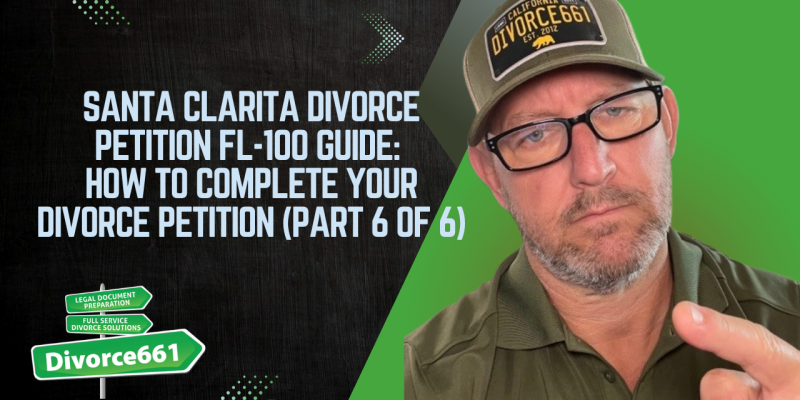Santa Clarita Divorce Petition FL-100 Guide: How to Complete Your Divorce Petition (Part 6 of 6)
Filing for divorce can feel overwhelming, especially when it comes to completing the official paperwork. To help you navigate this process, I’ve created a detailed, step-by-step guide on how to complete the California Divorce Petition form FL-100. This article concludes a six-part series designed to walk you through every section of the petition, making it easier for you to understand and file your divorce documents correctly.
As the owner of SCV Legal Doc Assist, a licensed and bonded legal document preparation service specializing in divorce, I’ve helped many people like you get through this challenging time with confidence. Below, I’ll cover the final sections of the FL-100 form, explain important legal considerations, and provide tips to ensure your petition is complete and accurate.
Completing Key Sections of the Divorce Petition FL-100
Requesting Court Orders on Spousal Support and Property
When filling out your petition, you’ll encounter several checkboxes related to financial and property decisions:
- Checkbox 7g: Select this box if you want the court to end its ability to order you to pay spousal support to your spouse.
- Checkbox 7h: This box requests the court to make decisions about dividing separate and community assets and debts. It’s important to check this box unless you are absolutely certain there are no assets or debts to divide. Even if you and your spouse have already agreed on these issues, the court needs to be formally involved to finalize these decisions.
Changing Your Name After Divorce
If you took your spouse’s last name during the marriage and wish to return to your original name, check checkbox 7i. In the space provided, write the name exactly as you want it to appear after the divorce.
Additional Court Decisions
If there are any other issues you want the court to decide, check checkbox 7j. If you need more space to detail these issues, check the box below 7j and attach an additional page labeled “Attachment 7j.” Make sure to include your name, your spouse’s name, and the attachment title at the top of the page. You can use form MC-025 or a blank sheet of paper for this purpose.
Understanding Child Support and Court Orders
Item 8 of the petition explains that the court will order child support for any minor children from the relationship, whether they were born before or during the marriage or adopted. It also clarifies that anyone ordered to pay child support will be charged interest on any past-due amounts, emphasizing the importance of timely payments.
Important Restraining Orders in the Summons
Before signing your petition, it’s crucial to obtain and thoroughly read the summons (form FL-110). The summons includes standard restraining orders that:
- Limit what you can do with property, debt, or spending money while your case is pending.
- Prevent you from leaving the state with your children without permission from your spouse or the court.
By signing the petition, you agree to obey these restraining orders, and once the petition is served, your spouse will also be required to follow them.
Signing Your Petition: Legal Accuracy and Final Steps
When you sign the petition, you do so under penalty of perjury, meaning you swear that all information in the petition and any attachments is true to the best of your knowledge. Before signing, double-check every detail to ensure accuracy.
On the signature line, write the date, then print and sign your name. At the bottom of the petition, you’ll find a notice explaining how divorce or legal separation may affect various aspects of your life, such as wills, retirement plans, life insurance policies, joint bank accounts, and other rights that married couples have. If you have any questions about these matters, it’s advisable to consult a lawyer for legal advice.
Additional Forms You’ll Need to File Your Divorce Case
Completing the FL-100 petition is just one part of starting your divorce case. At a minimum, you’ll also need to file the following forms:
- FL-110 (Summons): This form must accompany your petition.
- FL-105 (Declaration Under Uniform Child Custody Jurisdiction and Enforcement Act): Required if you have children with your spouse.
Additionally, if you have children, be aware of two local forms that may be required but were not covered in the tutorial:
- Family Law Case Cover Sheet: A local form specific to your jurisdiction.
- Notice of Other Cases Involving Minor Children: This form discloses other cases related to your children.
Final Thoughts
Filing for divorce and completing the FL-100 petition can be challenging, but with clear instructions and careful attention to detail, you can successfully navigate the process. Remember, this guide completes a comprehensive six-part series on filling out the FL-100 petition, designed to make the paperwork less daunting.
If you prefer professional assistance instead of piecing together information from multiple sources, consider reaching out to a licensed and bonded legal document preparation service like SCV Legal Doc Assist. We specialize in divorce paperwork and can prepare your forms accurately, saving you time and stress.
Divorce is a difficult journey, but with the right guidance, you can take confident steps toward a fresh start.

